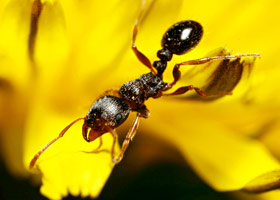Pavement Ant, Tetramorium caespitum

Joseph Berger, Bugwood.org.
IPM Steps to Reduce Pavement Ants
1. Sample for Pest
Before taking any action, confirm the presence of more than one ant—it may have come in on clothing or packaging. Inspect the adjacent areas along walls (interior and exterior) now and again later. Develop a knowledge of where ants are likely entering and make a practice to inspect and anticipate.
Where to find it while inspecting: Inspect along the ground floor first. You may be able to track ant activity to their outside nest as they follow scent trails. Pavement ants are most active at night. Trails can be along carpet tack strips or electrical wires and water pipes throughout a building. Underground nests show up by the small piles of soil near the entrance.
2. Proper ID
To best treat a pest, you must be sure what it is.
Size: Workers are small, 1/16"–1/8" (2.5–3 mm long), dark brown to black
3. Learn the Pest Biology
Ants follow scent trails to and from food sources.
Life Cycle: Winged males and females may be noticeably active in warm weather but generally you’ll only see workers on trails foraging for food throughout spring and summer and fall.
Preferred Food Sources: Food sources include other insects, plant juices and a wide variety of foods containing sugar and protein. Workers will locate and create a scent trail to any food source, usually at night, except in spring when they remain active during the day as well.
Preferred Habitat: Pavement ants prefer to build nests under ground, under rocks and debris and of course, under sidewalks, patios and foundations. They occasionally nest under floors and inside walls. They do not damage buildings nor do they bite or spread disease.
4. Determine Threshold
If you’ve seen ant activity, you need to act.
Threshold: One or more ants can be the beginning of a problem if you have any accessible food source (this includes greasy areas in kitchens and any food debris or crumbs in out of the way places).
5. Choose Tactics
IPM for indoor pests is always a combination of exclusion and sanitation: Don’t provide access to water, food and shelter!
Best Management Practices: Extreme care in keeping food use areas clean. This includes sweeping and mopping floors, and making sure to keep food debris from being embedded in corners and along baseboards. Clean up spills promptly and keep all food in pest-proof containers. Caulk/Seal all cracks and holes in foundation, walls, windows, weather-stripping, door sweeps and screens.
Treatment Methods: After reducing any source of food debris or grease inside your building, you may have to use baits. These baits contain slow-acting pesticides that are carried back as food to the nest and slowly kill the colony. Therefore, baits must be kept out of reach of children, and ants must be allowed to take bait back to the colony (be patient and do not kill ants you see using the bait traps) Depending on the quantity of ants, you may have to replace used bait traps with newer ones before the procedure has been effective (sometimes up to two weeks, but generally less time is needed). At times a perimeter treatment is used as well as direct-treatment by pesticides on nests.
6. Evaluate
Was the tactic successful? Record the date pests were first noted, and the tactic you used, and its success. Use one of our RECORD KEEPING tools.
For More Information:
Penn State Entomological Notes: Pavement Ant (PDF)
Maine School Pest Solutions: Ants (PDF)
Remember:
When a pesticide application is necessary, all necessary and required precautions are taken to minimize risk to people and the environment and to minimize risk of pesticide resistance or pest resurgence. Pesticide use in your school may be prohibited or regulated by local policies or state and federal regulations. Risk reduction methods can include, but are not limited to, spot-treatment, the use of gel or paste bait formulations placed in inaccessible locations, injection into a crack or crevice, and other methods that reduce potential exposure.